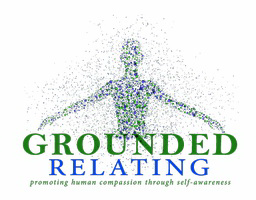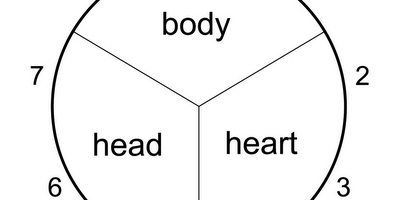The Enneagram maps three Centers of Intelligence
The first and easiest access point into the Enneagram’s knoweldge base is its three Centers of Intelligence. Although there are only three Centers of Intelligence, when we look at the three Centers, we will still be dealing with all nine types.
Essentially, according to the Enneagram, there are three types of human archetypes, with two variations each, making for a total of nine basic archetypes. These nine basic archetypes may be further subdivided into 27 variations, and then again subdivided by another factor of three (and again by a three factor, and so on).
Because there are many “sets of three” in the Enneagram of Personality, there are also multiple ways to unpack the whole of the Enneagram into bite-size pieces on scales of three. So don’t worry; it usually takes a while to absorb this complex data. You may not get it all incorporated on the first pass. Or the third pass. That’s okay!
That’s part of its charm; the Enneagram is ever new and surprising with its layered nuances of insight upon insight, that continue to evolve over time, even decades of time! If you use the Enneagram to just become a number, and use that number to forgive and explain away your bad habits, then you have missed the point. The point is to use the Enneagram as a platform for self-witnessing, self-discovery, and personal growth. After decades of study, and hours of witnessing yourself, the Enneagram will continue to quietly unveil your innermost self to you, revealing more aspects, cubbies, and corners of yourself, perhaps previously unknown and most likely untended.
But remember, while we actually are our type, we are also so much more than our type! And you may need or not need the different Enneagram sets of three at different stages of your life; places in your career; aspects of your tick-tock work-a-day existence; in love life settings; wherever! The Enneagram will meet you where you are, in all of those settings, if you let it. And, once you gain familiarity with the Enneagram of Personality, then its system or protocol of viewing data and experience, is available 24/7, to track YOU back to that place of personal bliss or satiety in Reality As It Is Now.
While there are nine distinct types listed on the Enneagram symbol itself, an internet search will quickly reveal there are many versions of the names for the nine types. Only one set of Enneagram Type names will be listed below, but the names themselves, are not set in stone. Rather these Enneatype names just “point” in the direction of this complex, nuanced, nested set of three.
Centers of Intelligence: Head, Heart and Body
This particular Enneagram set of three, or this particular way of organizing the Enneagram’s symbology is generally called the three Centers of Intelligence, and it is just one of the many ways the Enneagram may be unpacked. The essence of what the three Centers of Intelligence purports, as opposed to the yin-yang universal symbol based on a set of two, is that there are three basic intelligence forms or systems by which human nature may arise: Head Types, Heart Types, and Body Types. And each of these types of intelligences have predictable patterns of behavior. The Body Type is also known as the Gut or Belly Type and has to do with a primal or instinctual “knowing” from and of the body. The Heart Types are associated with Emotions, Esteem and Image, while the Head Types are associated with Reason, Planning or Intellect.
Now everybody has a head, a heart and a body; everybody has that. Heart Types aren’t without a mind; Body Types aren’t without a heart, Head Types aren’t without a body, and so on. Just like every now and then normally chatty people need some amount of quiet or downtime. Similarly, normally quiet, non-communicative people get a wild hair and become Chatty Cathy’s, however briefly. And every last one of us has experienced their own version of an emotional meltdown at some point in their lives. Right? Right!
Of course there are all sorts of in-between variables available for us humans to try on as it seems to suit. The point is, we all have access to everything, but usually one preference dominates, or is used more easily and more often. In the Enneagram, one of these Three Centers of Intelligence is the fast track of knowing or energetic metabolism for the Enneagram types listed under it.
Driving force behind the Centers of Intelligence
For the Head Types, the primary emotion that drives their functioning is actually Fear. However, on the surface this energy or habit of fear, might look a lot more like Rationality or Reason. Each of the three Head Types has a distinctive method of using their fear to control life in three very different and distinct Enneatype ways.
The same is true of the Heart Types who are driven by a need for Affirmation from the outside world. But if you were able to get under the hood of that engine driven for affirmation, what you might see is something that may more accurately be described as Grief or Loss of Identity of the essential self. Each of the three Heart Types will express this drive in three distinct Enneatype ways.
The Body Types primarily deal with Anger: one type may openly express anger, another may deny the anger, and the third type may go unconscious to their own anger. All three Anger or Body Center of Intelligence types struggle with three distinct forms of Self-Forgetting.
For a more detailed discussion of the Enneagram’s Centers of Intelligence, read Peter O’Hanrahan’s “Access for Self Awareness and Growth”. For a lighter or shorter read, try “Enneagram: Primary Triads and Emotions” by Claudio Del Piano. Ginger Lapid-Bogda’s, website The Enneagram in Business, also has great information the Head, Body and Heart Types on the Enneagram History and Theory page.
Using the Enneagram for self-awareness
This doesn’t mean a person of a particular Center of Intelligence, will necessarily have an awareness they are driven by anger or fear or grief. Discovering this habitual way of processing experience in their daily living is part of bringing in self-awareness into the present moment. So naturally, if one hasn’t been trained to bear witness to our habits of attention, this data set may not be currently visible to a person. In a similar way, we are not always aware when our hearts beat, or when our lungs breathe, but it is generally accepted these things occur, with or without our awareness.
“Beautiful things about the Enneagram:
Practicing….or witnessing the Self…or Other in action….without attachment to outcome, builds awareness, which fuels consciousness-states. Awareness is a choice and a discipline. And knowledge of the Enneagram of Personality provides a daily workout system for developing…that awareness and inner intuitions.”
However, we can actually bring our awareness to our bodies and witness, listen, look for, and feel our heartbeat in the internal cavity of our ribs. We might also feel the pulse of our heartbeat and blood circulation in various parts of our body. And when paying attention, it is easy enough to feel our lungs expand as we breathe in air that we can track from our nose to our belly and back again.
Helen Palmer uses the phrase “consciousness-states.” Practicing the observation of the internal breath process can be very informing. Also informing is witnessing the Self in action, or the Other in action, or the combination of the Self and Other interacting together. Witnessing without attachment to outcome builds awareness, which fuels consciousness-states. Awareness is a choice and a discipline. And knowledge of the Enneagram of Personality provides a daily workout system, open twenty-four hours a day every day, for developing personal and inter-personal awareness and inner intuitions.
Just like a person may have a strong preference to enjoy downtime as an Introvert might, in the Enneagram, a person is more comfortable or more naturally drawn to a Center of Intelligence. There are also people who have strong preferences to never, or rarely, be alone. This has been called Extroversion by some. Introversion and Extroversion are fairly well-known terms, just like yin and yang, and also another polar dichotomy. But the Enneagram is based on threes.
Curious about the mysterious Enneagram?
There is plenty to read or participate in to help you learn more about the Enneagram. The following series of articles will give you a broad base understanding about the Enneagram, its history, the nine basic Enneatypes and the three Centers of Intelligence. If you are interested in more information, contact us directly using our Grounded Relating contact form. Otherwise, please enjoy the following articles:
- Enneagram historical origins remain cloaked
- Universal Enneagram symbol explains life
- What is an Enneagram of Personality symbol?
- Three Centers of Intelligence mapped by Enneagram (this article)
- Core Enneatypes and Enneagram variations
- Enneatypes: nine archetypes of the Enneagram
- Suggested books, websites and other Enneagram resources
Balancing the three-legged stool
It is likely, many people already know their preference for a particular Centers of Intelligence; or they may know a loved one’s preference, or a good friend’s. It’s not rocket science, really; but it does take awareness and discipline to observe these things in action. And awareness up-front is especially helpful for changing automated habits, behaviors and preferences.
The trick, or the growth point, is learning to recognize your personal use of each of the three Centers of Intelligence. Which is your habitual favorite? Do you find you use two about the same amount of the time? Is there one of the three Centers of Intelligence that you habitually play down, ignore, or just aren’t aware of functioning in your life?
Kathleen Speeth and Helen Palmer are both known to use the idea of a three-legged stool to explain the nuanced sets of three which compose the Enneagram in all of its variations. Here’s how that image of a stool can work to bring in self-awareness. One of your three legs on the stool may be perfectly balanced, or even two legs of the stool are perfectly balanced. But rarely are all three legs of the stool perfectly balanced, without a disciplined practice of daily self-awareness.
Perhaps you maintain balance by rotating reliance on two of the legs of the stool, perchance remaining asleep to the fact that you actually sit on, and have access to all of the resources of a three-legged stool. In this way you can use the Enneagram to understand yourself forever poised, on a three-legged stool, dynamically balanced, as you witness use of one leg, two legs, and three legs of the stool.
There are many ways to use this metaphor, but for the purposes of this article, the three-legged stool would be the three Centers of Intelligence: Mind, Heart and Body. Transformation can occur for Head Types when they get out of their heads, and start accessing the wisdom inherent in their bodies and their hearts. Heart Types can be informed by the wisdom outside of relationship, by internal wisdom, housed within their own body or their own mind. Body types might remember they have needs, either mental or emotional, when they can choose to pause and listen to their hearts and heed what their head is telling them.
Although there are only three Centers of Intelligence, their data set represents nine individuated and distinct ways of manifesting as human. The study of these three Centers is only one of the many paths the Enneagram can offer to the seeker of bliss alongside both internal and external peace and balance.
Below follows a concise chart of The Enneagram’s Three Centers of Intelligence.






